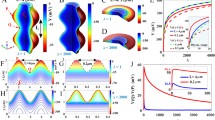Summary
Electrical excitation is interpreted in terms of a cooperative structural transition of membrane protomers coupled with the translocation of a permeant molecule in a non-equilibrium environment. Equations for flow of permeant and for membrane conformation are derived for the simple case of a single non-charged permeant. On the basis of a few simple physical assumptions, the theory predicts several important properties of electrically excitable membranes: the steepness of the relation between membrane conductance and potential, the presence of a negative conductance, and the occurrence of instabilities following rapid perturbations of membrane environment, giving rise to some simple cases of action potentials. Several experimental tests of the membrane with its changes of electrical properties are proposed. From a thermodynamic point of view, an electrically excitable membrane, in its resting state, lies beyond a dissipative instability and consequently is in a non-equilibrium state but with stable organization, a “dissipative structure” of Prigogine. Membrane excitation following a small perturbation of the environment would correspond to a jump from such an organization to another stable organization but close to thermodynamic equilibrium. It is shown how the cooperative molecular properties of the membrane are amplified by energy dissipation at the macroscopic level.
Similar content being viewed by others
References
Adam, G. 1968. Theorie der Nervenerregung als kooperativer Kationenaustausch in einem zweidimensionalen Gitter. I. Ionenstrom nach einem depolarisierenden Sprung im Membranpotential.Z. Naturforsch. 23b:181.
Adelman, W. J., Senft, J. P. 1968. Dynamic asymmetries in the squid axon membrane.J. Gen. Physiol. 51:102S.
Baker, P. F., Hodgkin, A. L., Shaw, T. I. 1961. Replacement of the protoplasm of a giant nerve fibre with artificial solutions.Nature 190:885.
Blumenthal, R., Changeux, J. P., Lefever, R. 1970. Une théorie de l'excitation électrique des membranes biologiques.Compt. Rend. Acad. Sci., Paris 270D:389.
Carnay, L., Barry, W. H. 1969. Turbidity, birefingence and fluorescence changes in skeletal muscle coincident with the action potential.Science 165:608.
Changeux, J. P. 1961. The feedback control mechanism of biosyntheticl-threonine deaminase byl-isoleucine.Cold Spring Harbor Symp. Quant. Biol. 26:313.
— 1966. Responses of acetylcholinesterase fromTorpedo marmorata to salts and curarizing drugs.Mol. Pharmacol. 2:369.
— 1969. Remarks on the symmetry and cooperative properties of biological membranes.In: Nobel Symp. No. 11, Symmetry and Function of Biological Systems at the Macromolecular Level. A. Engström and B. Strandberg, editors. p. 235. John Wiley, New York.
Changeux, J. P., Blumenthal, R., Kasai, M., Podleski, T. 1970. Conformational transitions in the course of membrane excitation.In: Ciba Foundation Symposium, Molecular Properties of Drug Receptors. (in press)
—, Podleski, T. R. 1968. On the excitability and cooperativity of the electroplax membrane.Proc. Nat. Acad. Sci. 59:944.
—, Rubin, M. M. 1968. Allosteric interactions in aspartate transcarbamylase. III. Interpretations of experimental data in terms of the model of Monod, Wyman and Changeux.Biochemistry 7:553.
—, Thiéry, J. 1968. On the excitability and cooperativity of biological membranes.In: Regulatory Functions of Biological Membranes. J. Jarnefelt, editor. BBA Library, Vol. 11. Elsevier, Amsterdam.
——, Tung, Y., Kittel, C. 1967. On the cooperativity of biological membranes.Proc. Nat. Acad. Sci. 57:335.
Cohen, L. B., Keynes, R. D., Hille, B. 1968. Light scattering and birefringence changes during activity.Nature 218:438.
Cole, K. S. 1955. Ions, potentials and the nerve impulse.In: Electrochemistry in Biology and Medicine. T. Shedlovsky, editor. p. 121. John Wiley, New York.
— Moore, J. W. 1960. Potassium ion current in the squid giant axon: Dynamic characteristic.Biophys. J. 1:1.
Dodge, F. A., Frankenhaeuser, B. 1959. Sodium currents in the myelinated nerve fibre ofXenopus laevis investigated with the voltage clamp technique.J. Physiol. 148:188.
Erlanger, J., Gasser, H. S. 1937. Electrical signs of nervous activity. University of Pennsylvania Press, Philadelphia.
Gerhart, J. C., Pardee, A. B. 1962. The enzymology of control by feedback inhibition.J. Biol. Chem. 237:891.
Gordon, R. 1968. Steady-state properties of Ising lattice membranes.J. Chem. Phys. 49:570.
Grundfest, H. 1966. Heterogeneity of excitable membranes: Electrophysiological and pharmalogical evidence and some consequence.Ann. N.Y. Acad. Sci. 137:901.
Hill, T. L. 1956. Statistical Mechanics. McGraw-Hill, New York.
— 1967. Electric fields and the cooperativity of biological membranes.Proc. Nat. Acad. Sci. 58:111.
Hill, T. L., Kedem, O. Studies in irreversible thermodynamics. III. Models for steady state and active transport across membranes.J. Theoret. Biol. 10:339.
Hille, B. 1968. Pharmacological modification of the sodium channels of frog nerve.J. Gen. Physiol. 51:199.
Hodgkin, A. L. 1964. The Conduction of the Nervous Impulse. Liverpool University Press, Liverpool.
— Huxley, A. F. 1952. A quantitative description of membrane current and its application to conduction and excitation in nerve.J. Physiol. 117:500.
Katchalsky, A., Spangler, R. 1968. Dynamics of membrane processes.Quart. Rev. Biophys. 1:127.
Koshland, D. E. 1963. The role of flexibility in enzyme action.Cold Spring Harbor Symp. Quant. Biol. 28:473.
Lapicque, L. 1909. Definition expérimentale de l'excitabilité.Compt. Rend. Soc. Biol. 67:280.
Lefever, R. 1968. Dissipative structures in chemical systems.J. Chem. Phys. 49:4977.
— Nicolis, G., Prigogine, I. 1967. On the occurrence of oscillations around the steady state in systems of chemical reactions far from equilibrium.J. Chem. Phys. 47:1045.
Mauro, A. 1962. Space charge regions in fixed charge membranes and the associated property of capacitance.Biophys. J. 2:179.
Monod, J., Changeux, J. P., Jacob, J. 1963. Allosteric proteins and cellular control systems.J. Mol. Biol. 6:306.
—, Jacob, F. 1961. General conclusions: Teleonomic mechanisms in cellular metabolism, growth and differentiation.Cold Spring Harbor Symp. Quant. Biol. 26:389.
—, Wyman, J., Changeux, J. P. 1965. On the nature of allosteric transitions: A plausible model.J. Mol. Biol. 12:88.
Mueller, P., Rudin, D. O. 1968. Resting and action potentials in experimental bimolecular lipid membranes.J. Theoret. Biol. 18:222.
Mullins, L. J. 1956. The structure of nerve cell membranes.In: Molecular Structure and Functional Activity of Nerve Cells. p. 123. American Institute of Biological Sciences, Washington, D.C.
Nachmansohn, D. 1959. Chemical and Molecular Basis of Nerve Activity. Academic Press, New York.
Narahashi, T., Moore, J. W. 1968. Neuroactive agents and membrane conductance.J. Gen. Physiol. 51:93S.
Podleski, T. R., Changeux, J. P. 1970. On the excitability and cooperativity of the electroplax membrane.In: Fundamental Concepts of Drug-Receptor Interactions, Proc. 3rd Ann. Buffalo-Milan Symp. on Mol. Pharmacol. August 28th, 1968. F. Danielli, J. F. Moran and D. J. Triggle, editors. 93. New York Academic Press.
Prigogine, I. 1967. Introduction to Thermodynamics of Irreversible Processes. Interscience Publ., New York.
— 1969a. Structure, Dissipation and Life.In: Theoretical Physics and Biology. M. Marois editor. North Holland Publishing Co., Amsterdam.
Prigogine, I. 1969b. Dissipative structures in biological systems. Report at the 2nd Intern. Conf. on Theoret. Phys. & Biol. Institut de la Vie, Versailles, July, 1969. To be published by North Holland, Amsterdam.
—, Lefever, R. 1968. Symmetry breaking instabilities in dissipative systems II.J. Chem. Phys. 48:1695.
—— Goldbeter, A., Herschkowitz-Kaufman, M. 1969. Symmetry breaking instabilities in biological systems.Nature 223:913.
— Nicolis, G. 1967. On symmetry breaking instabilities in dissipative systems.J. Chem. Phys. 46:3542.
Strässler, S., Kittel, C. 1965. Degeneracy and the order of the phase transformation in the molecular field approximation.Phys. Rev. 139:A758.
Tasaki, I. 1968. Nerve Excitation: A Macromolecular Approach p. 201. C. Thomas, Springfield, Ill.
— Carnay, L., Sandlin, R., Watanabe, A. 1969. Fluorescence changes during conduction in nerves stained with acridine orange.Science 163:683.
— Watanabe, A., Sandlin, R., Carnay, L. 1968. Changes in fluorescence, turbidity and birefringence associated with nerve excitation.Proc. Nat. Acad. Sci. 61:883.
Author information
Authors and Affiliations
Rights and permissions
About this article
Cite this article
Blumenthal, R., Changeux, JP. & Lefever, R. Membrane excitability and dissipative instabilities. J. Membrain Biol. 2, 351–374 (1970). https://doi.org/10.1007/BF01869870
Received:
Issue Date:
DOI: https://doi.org/10.1007/BF01869870




